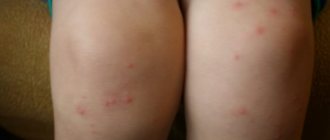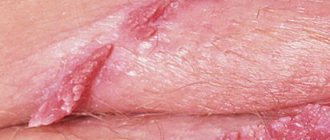Chickenpox on the genitals
Chickenpox is mostly a pediatric disease, that is, it mostly affects younger patients (preschoolers and early schoolchildren). But if a person did not get sick in childhood, infection can occur in adulthood. As a rule, herpetic rashes are localized on the skin. Sometimes damage to the mucous membranes is possible, in particular, chickenpox is observed on the genitals of men and women. This is a dangerous and unpleasant condition that requires urgent treatment, since there is a high risk of complications.
How does this type of chickenpox manifest?
Chickenpox on the genitals looks like a rash typical of this disease. Herpetic rashes are very specific and go through several stages in their development. It is by the characteristic stages of “evolution” that the pathological process can be identified. The classic chickenpox papule goes through 4 stages of formation, but the last stage is absent on the mucous membranes.
- A small red dot (no more than 1-2 mm in diameter) forms in an intimate place . At the first stage, there is no papule as such, a flat, painless spot develops that does not manifest itself in any way.
- After 1-2 days, a small pimple begins to rise above the skin. A full-fledged papule is formed: a bubble-like formation filled with exudate (intercellular fluid, lymphocytes and dead herpes pathogens).
- Then the so-called vesicle appears - this is the final stage of papule development, when the herpetic blister bursts and begins to ulcerate.
- Finally, in the fourth stage, the process is resolved with the formation of a hard crust.
With rashes in the groin, a crust does not form. Therefore, all worries regarding the fact that scars will remain on the genitals are groundless. At all stages of the disease, the following symptoms are observed:
- Itching in the genital area. It is caused by the activity of the pathogen.
- Burning sensation.
- There may be pain when urinating. This is a worrying sign. It is necessary to carry out a differential diagnosis of chickenpox and some sexually transmitted diseases (in particular, genital herpes). If smallpox papules are localized on the mucous membranes of the urethra, it is unlikely to be possible without consulting a urologist.
- Increase in body temperature to subfebrile-febrile values.
- Intense pain syndrome. There are many nerve endings located on the genitals, so severe pain is a common occurrence.
- Swelling of the mucous membranes and surrounding tissues.
Localization Features
The location of chickenpox papules is very typical. In girls (girls), smallpox is located on the labia majora and minora. It is possible that the infectious process can be transferred to the mucous membrane of the vagina and urethra, which happens with intense scratching.
In boys, the typical location is on the penis. The foreskin and glans suffer. A characteristic feature of chickenpox on the penis is the high intensity of its manifestations: it gets to the point that a man cannot wear underwear due to extremely unpleasant sensations. Sexual activity also becomes impossible. Most often, papules are located on the skin of the foreskin on the outer side . With mechanical spread of the process, damage to the urethra is possible. Chickenpox on the penis is generally much more difficult to tolerate.
Rash on butt
Small red, goose bump-like rashes on the butt often appear in children in the first 12 months of life. It is impossible to determine on your own the true cause of the spots. Based on the clinical picture and shape of the rash, parents may suspect one of the conditions.
- Allergic reaction to tangerines, sweets or other foods. The buttock area can also turn red from medications that are often prescribed to children (Nurofen, Viferon, Sub-Simplex, penicillin antibiotics and other drugs).
- Diapers can cause a maculopapular rash on the butt. This often happens when changing hygiene products. You should give preference to hypoallergenic brands of diapers and change them promptly.
- Homemade diapers often cause irritation on the butt. Visually, it resembles a miliaria - small reddish pimples with whitish nodules in the center. With this condition, the baby may be diagnosed with diaper dermatitis.
- Prolonged exposure to high ambient temperatures causes a rash on the butt. Subsequently, the spots spread throughout the body.
- Childhood diseases can begin with a rash on the butt. Fever often precedes the appearance of redness. Differential diagnosis allows you to make one of the diagnoses: scarlet fever, chickenpox, rubella, measles, Epstein-Barr virus, Coxsackie disease, molluscum contagiosum and others.
- Parasitic infections appear as a rash near the anus. If left untreated, the spots spread to the liver area, lower and upper limbs, and areas of the face. Such signs are characteristic of Giardia and yersiniosis.
- Autoimmune diseases cause skin manifestations with a predominant localization in the gluteal region and lower extremities. When diagnosed, a child may be diagnosed with diabetes, pemphigus, and lupus. The reaction occurs due to inappropriate behavior of the body's defense systems.
How to identify the disease
Identification of the pathological process is the prerogative of the doctor. It is necessary to contact a pediatrician if a child is sick, and for adults - a dermatologist. In patients who are sexually active, it is necessary to conduct a differential diagnosis so as not to miss the development of sexually transmitted diseases. For this purpose, a smear is taken from the urethra for further microbiological examination. Exudate from papules of suspected chickenpox is also analyzed. Making a diagnosis is most often not a problem.
How to relieve the condition
How to treat the genitals to relieve discomfort? Specialized medications will help. Among them:
- Antihistamine ointments, for example, Fenistil.
- Antiseptics - brilliant green, Fukortsin. These medications are used to spot-smear the rashes.
- Anti-infective drugs - Desitin.
Traditional methods will be a good help:
- Coldness to the affected area. Regular ice will do. In the absence of ice, you can use frozen foods that are on hand.
- Sage infusion (500 ml of boiled hot water per 2 teaspoons of crushed raw materials). The product is used for compresses and baths.
- Baths with potassium permanganate, they should be taken for no more than 10-15 minutes.
Prevention measures and useful tips
- It is necessary to carefully monitor hygiene. Take a shower at least twice a day, change your underwear and bedding regularly.
- Wear only cotton underwear.
- You can use ointments based on mumiyo. They have a softening effect, accelerating the healing process of wound surfaces.
- During the period of illness, it is not recommended to use aggressive household chemicals, such as soap (it contains alkali). You should also give up washcloths for a while: using them is a direct path to scratching.
- The use of Miramistin will be a good help . This drug was originally created to combat pathogens of sexually transmitted diseases, but it can be an indispensable tool in stopping chickenpox.
- Wearing tight underwear is strictly prohibited. Increased sweating will increase itching and irritation.
- Oral antihistamines can be used. First and third generation medications are suitable: Cetrin, Pipolfen, Tavegil, Suprastin.
- It is forbidden to scratch chickenpox rashes. By destroying the papules mechanically, the patient himself spreads the herpes pathogen to new areas of the skin.
- What else can I use to smear papules? Regular zinc ointment will do.
Prevention of candidiasis in infants
To prevent your baby from suffering from thrush that appears in the mouth and its unpleasant symptoms, it is necessary to prevent the disease:
- Parents carefully conduct their personal hygiene, as well as the hygiene of the baby, do not forget to wash their hands;
- When breastfeeding, the mother needs to keep her breasts clean. You can treat it with a soda solution before feeding;
- Baby's pacifiers, bottles and utensils must be thoroughly sterilized. It is also worth keeping an eye on the toys that the baby puts in his mouth while exploring the world;
- Try to boost your child's immunity. Breastfeeding helps to protect it as much as possible from viruses and bacteria that enter the body. Hardening and massages are also useful.
Parents should always remember that candidiasis in infants is a very dangerous disease. If it is not diagnosed in time and treatment is not prescribed, it can lead to serious consequences. Therefore, if you notice the first signs of candidiasis, you should not delay your visit to the doctor, who will help cure it as quickly and effectively as possible.
Thrush in newborn girls is common, as various unfavorable factors contribute to it. If the baby begins to refuse breastfeeding, and also begins to cry a lot and sleep poorly, then he may have developed candidiasis. This disease actively manifests itself in the mouth, especially in infants, so the signs and symptoms of the disease can be identified quite quickly. It is not difficult to treat oral thrush in newborns; the main thing is to detect the disease in a timely manner and correctly carry out complex therapy.
What is the disease? Thrush or, scientifically, candidiasis is a disease that affects the mucous membrane of the body. The causative agent of the disease is the microscopic fungus Candida, which lives in small quantities in the body of any person, including a newborn. However, boys should not be afraid of this microorganism, since candidiasis develops an order of magnitude less in them compared to girls.
What organs of newborns can be affected by the fungus?
These include:
- surface of the newborn's oral cavity;
- intestines;
- skin;
- mucous membrane of the genital organs (extremely rare).
It is important to note that a fungus belonging to the genus Candida brings significant benefits to the body - it is actively involved in the synthesis of vitamins belonging to group B. However, if the baby’s body is exposed to certain conditions, the fungus begins to rapidly multiply on the mucous membrane, thereby causing a lot of unpleasant sensations The child has.
Films similar to the remains of cottage cheese that appear in the mouth of girls are easy to notice, so often the disease does not develop into an advanced form that is dangerous to the health of the baby. But candidiasis of the genital organs in children brings with it more “troubles”, so starting its development is undesirable for the health of the baby.
Today, most often, newborn girls become infected with thrush from their mother during passage through the inflamed genital tract. In this case, candidiasis develops in infants in 98% of cases. Often, thrush appears in children's mouths, since the mucous membrane there is ideal for the proliferation of fungal spores.
Candidiasis of the oral mucosa develops in newborn girls due to the following factors affecting the body:
- dry air in the room, which causes a decrease in the amount of saliva, which protects the mucous membrane from harmful bacteria;
- rare walks outside;
- long cries of the baby, which also cause dry mucous membranes;
- difficulty breathing, which adversely affects the condition of the mucous membrane and its protective properties;
- indoor mold, which is considered an excellent breeding ground for bacteria.
What danger does thrush pose to newborn girls? If you ignore the symptoms of the disease, the entire oral cavity will be covered with a greasy and rough coating, under which there are bright spots that indicate the development of inflammation. If such skin lesions are severe, they may bleed constantly.
If the disease is too advanced, the spots form a thick white film on top of themselves, gradually covering the entire oral cavity. It is considered especially dangerous that the disease can spread to the child’s throat - this will cause severe pain. In this case, the baby will constantly cry, scream, and refuse to eat. There have been cases when candidiasis caused an increase in temperature and kept it at a high level.
In the absence of necessary treatment measures, spots increase the risk of developing a serious infection, which greatly harms the health of the baby.
The reasons for the appearance of candidiasis must be clarified by the doctor, because otherwise the treatment of thrush will not cause a complete recovery of the baby.
The most common causes of the disease are:
- The easiest way to infect girls is from the mother (during childbirth or through milk). A simple kiss or touch can also lead your baby to infection. Since the child’s immunity is too weak, fungi easily enter the body and begin to actively multiply there, causing a large amount of harm.
- If a mother neglects hygiene rules and does not keep her breasts clean, this can also lead to the development of candidiasis. Although this will not cause genital thrush in girls, the oral cavity will be susceptible to infection.
- Too dry or hot air can also cause the Candida fungus to become active in the body. After all, such an environment is considered excellent for the development of infection, especially since the body’s defenses will not be able to completely cope with it.
- If there is a disturbance in the microflora in the body, for example, as a result of treatment with antibiotics, you can also expect the child to become infected with candidiasis. In this case, it is necessary to prevent the disease, as well as restore normal microflora.
- Any form of the disease can be caused by a decrease in the protective properties of saliva, which often happens in newborns.
Infection of the genital lining in young children occurs much less frequently. In addition, it develops for other reasons that constantly affect the body of children.
If white, cheesy discharge appears in the mouth, this may be a sign of the development of one form of candidiasis.
It is worth noting that doctors regularly discover new subtypes of this disease:
- acute form - the first stage of development of the pathology, when the symptoms of the disease are too pronounced;
- chronic form - if parents ignore the symptoms of the disease or begin to independently treat their baby, this can aggravate the course of candidiasis and cause an advanced form;
- candidal sepsis is the most severe and rare form of thrush, during which serious infection of the blood and internal organs occurs in newborns (fortunately, this is extremely rare, since sepsis, in most cases, appears after immunodeficiency syndrome, which is rare in infants with proper development).
If unknown signs are detected, the baby must visit a pediatrician!
The disease got its name not by chance, because the main symptom of thrush is the appearance of a white coating in the oral cavity, which in appearance resembles milk. It is important to note that many young mothers do not always notice this sign of candidiasis, believing that the plaque appeared after eating. However, this symptom does not look like the remains of mother's milk.
Usually a white coating on a baby does not cause discomfort or pain. At the initial stage of the disease (acute form), plaque can be easily and quickly removed with a spoon, napkin or soda solution.
In other words, the condition of the newborn at the beginning of the development of the disease will not be much different - the only thing the mother can notice is capriciousness, lethargy and the appearance of a white film on the oral mucosa, which will not be washed off after the child drinks water.
It is important to note that an infected oral cavity in a baby can also infect the mother, since cracks in the mouth that appear can easily transmit a fungal infection to the skin of the breast.
If plaque appears in the mouth, you should not hesitate, because the sooner the disease is detected, the faster the doctor will diagnose and prescribe comprehensive treatment for the baby. As a rule, a woman with a newborn girl needs to visit a pediatrician, who needs to explain the symptoms noticed in the baby.
It is important to note that it is prohibited to independently treat oral candidiasis, otherwise this will lead to unpleasant consequences for the baby and will also aggravate the course of thrush.
In the first month of a newborn’s life, medications containing nystatin are prescribed. Such drugs effectively and safely fight pathogenic microflora, namely fungi of the genus Candida.
Since these medications are considered antibiotics, they are available in various forms.
Any medications to get rid of the pathology must be prescribed by a doctor who will take into account the age of the newborn, her state of health, and so on.
In addition to taking antibiotics, you can also smear the nipples with honey, which is considered a disinfectant and anti-inflammatory agent; it is recommended to rinse the mouth with a 2% soda solution. To do this, it is permissible to use a clean bandage or finger, which gently wipes the mucous membrane, tongue, and palate affected by the fungus. It is worth noting that this method also eliminates the unpleasant symptoms of the disease, which cause significant discomfort to the child.
You can carry out soda procedures 4-5 times a day (it is advisable to do this after meals). Soda does not harm the health of a newborn girl, so you can use it without fear for the child’s health.
Is chickenpox sexually transmitted?
The mode of transmission of chickenpox is airborne. Any physical contact with an infected person is fraught with the onset of the disease. Therefore, it is recommended to give up intimacy for a while if the other partner has never had chickenpox before. But the disease is not transmitted through sexual contact .
Chickenpox on the genitals causes more discomfort because the groin area is more tender and sensitive. However, there are no fundamental differences either in diagnostic tactics or in the choice of therapeutic measures.
source
Chickenpox on the labia - Correct treatment for girls and boys
With moderate and severe chickenpox, the rash spreads not only on the body, but also on the mucous membranes. Chickenpox on the genitals is often found in children, and on children's forums parents ask questions: “What if a girl has chickenpox on her pussy? What to do when a rash appears on the labia? How to treat and smear the boy’s?”
Chickenpox on the genitals definitely requires proper treatment, since the consequences can affect the genitourinary system in children.
Recurrences of genital herpes in children
Recurrence of genital herpes begins with the appearance of precursor symptoms, expressed by burning, pain, swelling in the genital area. Later, a rash appears on the mucous membranes and skin. The vesicles contain a clear liquid that begins to become cloudy. The blisters burst, forming ulcers. After 7-9 days, the ulcers heal spontaneously, leaving no marks.
We invite you to familiarize yourself with Streptoderma in children and adults: photos, symptoms, treatment
Provoking factors for relapse are:
- direct contact with a carrier of the herpes virus;
- poor genital hygiene;
- decreased immunity;
- stress.
Causes of chickenpox on mucous membranes: how to prevent
The causes of chickenpox on the genitals are the severity of the disease. If in a mild form of chickenpox, the rashes are localized mainly on the body, then in moderate and severe cases they are found on the mucous membranes: in the mouth, on the tongue, on the membranes of the eyes and genitals.
The reasons for the spread of the rash below the waist include insufficient hygiene and improper treatment of chickenpox. Several rules must be followed to prevent the appearance of new acne in children on the genitals.
- Change your child's underwear every day or preferably 2 times a day during illness.
- It is better to use loose underwear made of natural cotton.
- Bedding should be changed daily during chickenpox.
- Do not scratch chickenpox. If the child is small (up to a year), then it is necessary to wear special mittens; over a year old - be sure to treat and give antihistamines.
The child’s behavioral motives must be controlled and not allowed to scratch chickenpox in intimate places. The adult’s task is to notice the rash in time and treat it correctly before severe, unbearable itching occurs.
Features of the disease in children of different ages
Herpes on the genitals of a child can appear at any age, in boys and girls.
Genital herpes is a viral infection that is transmitted through contact. Viral particles fall on the skin and mucous membranes, penetrate epithelial cells, causing characteristic changes in them, which is manifested by specific rashes in the form of grouped blisters.
Depending on the age of the child infected with genital herpes, the manifestations will be different.
In addition to age periods, the manifestations of herpes infection differ depending on the child’s immune status.
Genital herpes in infants and young children
A child's immunity during breastfeeding is at the stage of immaturity and formation.
There is insufficient production of interferon by leukocytes - the main antiviral component of immunity, immaturity of lymphocytes, which find it difficult to recognize the viral antigen and present it to other immune cells for the production of antibodies.
As a result, the risk of herpes infection spreading throughout the body increases.
Genital herpes in newborns has varying degrees of manifestation, which are determined by the process of pregnancy and the state of health of the baby.
During gestation, the mother transmits antiherpetic antibodies that protect the body from the virus during the first 9-12 months of life. However, not in all cases the antibody titer is sufficient.
In case of complicated pregnancy, pathology during childbirth, or diseases of the newborn, the amount of maternal antibodies may become insufficient for protection.
In such situations, infection of an infant with genital herpes will lead not only to rashes on the genitals, but also to the spread of the virus throughout the body.
Herpes in children under one year of age can cause the following conditions:
- typical rashes on the genitals;
- spread of the rash over large areas throughout the body;
- pelvic inflammation in girls;
- encephalitis, serous meningitis;
- neuropathy as a consequence of encephalitis;
- hepatitis.
Genital herpes in infants is dangerous due to frequent relapses. The disease can take on a wave-like character, the number of exacerbations can reach 3-10 episodes per year.
For little girls, genital herpes is dangerous due to its penetration through the vagina into the uterus and fallopian tubes, which leads to inflammation and the development of infertility in the future.
Children over one year old when infected with genital herpes more often suffer from its local manifestations than from generalized infection spreading throughout the organs. However, girls are at high risk of pelvic inflammation, since they do not yet have protective functions in the form of lactic acid vaginal bacteria.
Genital herpes in adolescents
Children during puberty are especially vulnerable to the effects of infections. The stage of hormonal changes is accompanied by a pronounced load on the organs of the immune system, so infectious diseases suffered during puberty often leave a mark on health. Infections interfere with the development of functions not only of the genital organs.
Genital herpes in older children is dangerous for both boys and girls.
Often, genital herpes suffered by a girl during adolescence leads to inflammation of the appendages, endometritis, and cervicitis. When the ovaries are involved in the process, the hormonal regulation of the menstrual cycle may also be affected.
Genital herpes in adolescents is dangerous due to the formation of persistent infertility.
At the stage of puberty in girls, when the estrogen saturation of the genital tract is still insufficient, the protective vaginal barrier from bifidobacteria and lactobacilli is poorly formed.
There is no proper destructive acidic environment yet and herpes viruses easily penetrate the tissues of the cervix, endometrium and tubes. In addition, herpes viruses in girls lead to the formation of pseudo-erosion of the cervix, and when simultaneously infected with human papilloma viruses, they create a high probability of developing cervical dysplasia.
Boys and girls infected with genital herpes become sources of infection and spread the virus through sexual contact.
Herpes in boys is dangerous due to the penetration of the virus into the tissues of the prostate gland. Prostatitis in a teenage boy can lead to persistent impairment of its function, and the spread of the pathogen along the vas deferens and vesicles can lead to impotence and infertility.
Involvement of the testicles in the infectious process leads to persistent impairment of spermatogenesis.
How to smear the labia with chickenpox - correct step-by-step treatment
Treatment of chickenpox should be comprehensive. General therapy for chickenpox is selected by the doctor, taking into account the patient’s condition. For chickenpox the following is prescribed:
- antiviral drugs - selected by the doctor, depending on the patient’s condition;
- anti-itch medications to make chickenpox itchy less, it is especially important to take antihistamines for children;
- ointments and solutions for treating the skin (zelenka, fucorcin, acyclovir, fenistil, etc.)
- Antibacterial therapy is selected by the doctor if chickenpox is severe and complications are suspected.
Step 1 - Wash the affected skin on the genitals
The most important thing in treating chickenpox on the genitals is to wash the child more often (2 - 3 times a day). If mucous membranes are affected in children, it is necessary to thoroughly rinse the affected skin. There are some general tips.
- The water should not be hot, you cannot use soap, gels, or foam washcloths.
- Before starting water procedures, some caring parents disinfect the water. To do this, you can add a few grains of potassium permanganate. Potassium permanganate is approved for use by children from birth; it is used when bathing babies until the umbilical wound heals.
- You can use infusions and decoctions of herbs - chamomile, calendula, celandine, oak bark and others. It is usually brewed at the rate of 1 teaspoon per 1 liter of water. You can buy chamomile in bags; it is less effective, but convenient for brewing.
- After washing, do not wipe the affected skin with a towel; it is better to let it dry naturally or blot it with a disposable paper towel.
Step 2 - Treatment of the genitals for chickenpox
Not all products are allowed for treating the genitals, but most of them have a drying effect. Let's look at the most common ones.
Zelenka
Many people associate chickenpox with brilliant green. Is it possible to use brilliant green if a rash is detected on the labia? Our answer will be: “Yes.” Zelenka remains the number 1 remedy in the treatment of chickenpox.
Brilliant green dries out the rash, has an antimicrobial effect and perfectly relieves itching. Used in medicine during operations and in maternity hospitals. Previously, and even now, there is a practice that in order to heal external seams, they are carefully lubricated with brilliant green.
In children, treatment should be targeted. Carefully use a cotton swab to coat each pimple.
It is better to replace brilliant green with another product, because brilliant green contains 100% alcohol, the skin of children in the intimate area is very delicate and the child can get burned.
Fukortsin (another name for Castellani)
A bright red remedy for treating chicken pox. Fukortsin is used to treat rashes on the body, and can also be used on the genitals of children. Fukortsin dries out pimples, has an antimicrobial, disinfectant and antibacterial agent. Treatment with the solution is allowed 1 - 2 times a day.
Why do acne appear on the genitals?
In fact, there can be many reasons for this problem.
Poor nutrition, bad underwear, stress, improper body care, infection, health problems - this is just a small list of why acne appears on the labia. The main thing is to understand what’s going on without resorting to radical methods. Remember: under no circumstances should you press, cauterize, or scratch formations on the skin. So, acne on the genitals could appear as a result of neglect or violation of personal hygiene rules. Please note that too frequent washing of the genitals can also lead to such formations. Don't forget that soaps, gels, balms and other cosmetic products not only remove dirt, but also destroy the natural environment of the skin. Because of this, the upper layers of the epidermis are deprived of natural protection, and bacteria begin to actively multiply on the surface.
Doctors recommend washing your face twice a day (morning and evening). And, of course, you need to swim before intimacy. Movement - from the tailbone to the pubis, otherwise an infection from the rectum may enter the vagina. By the way, you shouldn’t use soap every time. To avoid scratching your skin, dry with a soft towel. Naturally, it should be only yours.
Douching is dangerous for a woman's health. Previously, representatives of the fair sex tried to get rid of unwanted pregnancies and certain diseases. This is pointless, since sperm have time to reach the cervix forty seconds after ejaculation. However, such procedures destroy the vaginal microflora, as a result of which the girl may develop thrush, vaginosis, etc. diseases. Douching can only be done if it is prescribed by your doctor.
Often, small pimples on the genitals appear after a girl has shaved or removed her hair (with cream, wax, laser). They go away on the second or third day. However, there is one danger - ingrown hairs, which can become inflamed in the treated area. Therefore, it is so important to carry out such cosmetic procedures correctly.
Clothes can also injure your skin. The size of underwear plays an important role. If it squeezes, cuts, or rubs, try not to wear it. In any case, it is better to spend an extra two hundred rubles, but buy really good things that will not harm your health.
Don't be surprised if today you stood in the cold for forty minutes, and tomorrow you have a rash. Temperature changes negatively affect our health. Therefore, in the future, try to wear warm clothes. After all, beauty is not always worth the sacrifice. Please note that when hypothermia occurs, the pimples on the labia will be hard. They hurt a lot when touched, but do not itch.
Syphilis, psoriasis, herpes, candidiasis, scabies - this is just a small list of diseases that cause pimples and acne to appear on the genitals. And the sooner you start treatment, the less consequences of the disease will be. Therefore, it is so important to contact a dermatovenerologist in time.
DETAILS: How to remove warts under the breasts
Typically, acne is located on the mucous membrane of the genital organs, as well as near the anus. Syphilis is transmitted sexually, so you should stop having sexual contact with your partner until the tests come back. By the way, this disease does not manifest itself at first. Therefore, it is recommended to undergo a full examination not only for you, but also for those with whom you have recently made love.
A rash similar to sores appears on the genitals about a month to a month and a half after contact with the patient. This is an incredibly dangerous disease that can be fatal. Do not trust healers and knowledgeable people who got rid of this problem with the help of herbs and tinctures! Only a venereologist can carry out treatment.
The papilloma virus is transmitted during sex, from mother to child (through milk), and through close contact with a sick person. Tumors can only be removed surgically, using a laser, a special device that emits pulses, and similar modern means.
According to statistics, almost every second person is a carrier of HPV. This disease may not manifest itself for a long time until a malfunction occurs in the human body. Hypothermia, stress, lack of vitamins, poor nutrition - all this can awaken a “dormant” disease.
This virus is also sexually transmitted and appears when the immune system is weakened. Pimples cover the genitals and perineum of the fair sex. Inside such a formation you can see pus - a cloudy white liquid. If you are faced with a similar problem, it means that your health is not all right. Be sure to visit an immunologist.
The causative agent is the herpes simplex virus, which is transmitted by contact. Please note that almost 90% of the entire world population is a carrier of this disease. Women aged 21 to 36 years are at risk. Herpes pimples are small and soft to the touch. Outwardly, they look like sores. A rash can appear as a result of decreased immunity, stress or disruption of the endocrine system, etc.
This infectious disease occurs in both men and women. Therefore, if you have been diagnosed with this, both you and your partner will have to undergo treatment. There are many causes of thrush, ranging from hypothermia, pregnancy, to improper use of antibiotics. With candidiasis, pimples are large, red and with a whitish coating. Associated symptoms: pain during sex and urination, burning, itching of the genitals, as well as former cheesy vaginal discharge.
The carrier is pubic lice. You can become infected during sexual contact. The incubation period lasts about one month. If you contact a specialist, treatment will be quick and painless. Main symptoms: itching, rash, burning, discomfort.
DETAILS: Is it possible to do peeling for acne: recommendations from a dermatologist
Often the fair sex is allergic to low-quality products. If acne appears on the genitals, a woman should reconsider her underwear. Firstly, it must be made from natural fabrics. Synthetics, no matter how beautiful they are to you, should be thrown away. This material does not allow the skin to breathe, it does not absorb moisture.
The products you use in the shower play an important role. Please note that in most cases, dermatitis (rash, irritation, redness, inflammation) appears several hours after the water procedure. It is necessary to completely avoid contact with the allergen and undergo treatment under the supervision of a doctor.
If dermatitis is not treated, pimples can develop into ulcers. Therefore, it is necessary to undergo all tests to identify the allergen, as well as do an ultrasound of the pelvis. Remember once and for all: only a specialist can prescribe medications! You shouldn’t guess on the tea leaves, trusting your inner voice or the advice of your friends.
- Subcutaneous pimples - fatty cysts
If large bumps appear on your genitals that do not cause pain or itching, then these may be fatty cysts. They are formed as a result of blockage of the sebaceous gland duct. In some cases, acne becomes significantly smaller in size. And although this is not considered a disease, the fair sex should exercise caution.
In the future, it will be possible to get rid of pimple on the genitals only through surgery. Damaged tissue is cut out using a scalpel or laser. The patient then remains under the supervision of a specialist for several days. If the operation is successful, the patient is sent home. But antibacterial therapy is carried out in any case.
The incubation period after contact with the patient lasts about two weeks. In this case, a slightly pinkish rash is located both on the labia and on the pubis. If you touch the pimples, a white, cheesy substance will begin to ooze out. There will be no painful sensations.
DETAILS: Gynecology on Posadskaya in Orel telephone
Opinion of a pediatric gynecologist: what can and cannot be used
Pediatric gynecologist at the Nizhny Novgorod Children's Regional Clinical Hospital I. A. Dorokhina believes that for the toilet behind the external genitalia of young and younger girls (before the onset of menstruation) the following CANNOT be used:
- soap;
- soda;
- potassium permanganate;
- toilet paper;
- wet wipes.
For the toilet you CAN use:
- decoctions of black and green tea;
- herbal decoctions (calendula, chamomile and oak bark).
Decoctions are prepared at the rate of a tablespoon of dry herb per 1 liter of water.
If there is severe redness of the vulva or yellow or green discharge from the genital tract (due to infection), you should contact a pediatric gynecologist.
Treatment of thrush in newborns
Thrush in newborns is a rather unpleasant disease that prevents the child from eating normally, negatively affects the development of immunity and causes the death of the normal microflora of internal organs. It is easiest to treat thrush in newborns in the first stages of the disease, so as soon as you notice the appearance of white spots in the child’s mouth, you should immediately begin treatment.
1.
The simplest and most effective method, which has virtually no contraindications, is to treat the oral cavity with a soda solution. Dissolve soda in warm water, at the rate of 1 teaspoon per glass, then use a cotton swab or just a cotton swab, well soaked in the solution, wipe the inside of the child’s tongue and cheeks. In order for the newborn to open his mouth, it is enough to lightly press his thumb on the chin. You need to treat the mucous membranes very carefully and gently, under no circumstances pressing or trying to remove plaque. This can cause damage to the mucous membrane and re-infection of the oral cavity. You also need to treat nipples and bottles with a soda solution before feeding. It is advisable to treat the child’s mouth after feeding or every 3-4 hours until all signs of thrush disappear. Then you can continue processing for a few more days - for prevention.
2.
Treat the oral cavity with a honey solution - 1 teaspoon of honey to 2 tablespoons of warm water. Treat in the same way as with soda solution. This method is not recommended for use in newborns, since honey is a strong allergen. It is best used to treat older children.
3.
If there is no effect from soda wiping, pediatricians prescribe treatment of the oral cavity with antifungal drugs. This could be nystatin drops, Candida solution. But such treatment should only be carried out under the supervision of the attending physician.
4.
For genital thrush, treatment is also carried out with a soda solution or antifungal drugs. Baths of decoctions of medicinal herbs - calendula, chamomile and St. John's wort - help well.
Thrush in newborns is a disease that is much easier to prevent than to treat. Following the rules of personal hygiene, keeping the baby's dishes and pacifiers clean, healthy eating and strengthening the child's immunity will help avoid the appearance of not only thrush, but also other childhood diseases. In what ways have you dealt with thrush in your children? We are waiting for your advice in the comments.
Often, parents, faced with their baby’s refusal to breastfeed, notice the appearance of white plaque in the oral cavity. There is no need to panic, because thrush in infants is a very common phenomenon. Its appearance is a consequence of the infant’s still imperfect immune system and errors in caring for him.
Candidiasis is an inflammatory process that causes active reproduction of the candida fungus on the mucous membrane. There are a huge number of factors that precede the appearance of thrush in infants.
The causes of thrush in infants may be as follows:
- If the mother did not cure candidiasis before giving birth, then there is a high probability that the child will get it as it passes through the birth canal. Also, the baby may develop a white coating in the mouth when breastfeeding. Any family member who is negligent about their hygiene or suffers from thrush can infect an infant;
- The immune system of infants is still weakened and vulnerable to various viruses and infections. Also, the spread of fungus on the mucous membranes of the mouth can be provoked by its drying out, associated with non-compliance with the temperature regime in the house in which the child lives and insufficient humidity;
- Insufficiently sterile nipples, bottles and utensils for the baby;
- The presence of diseases leading to frequent regurgitation;
- In newborn girls, the appearance of thrush can be caused by infection with it in the womb;
- If a child comes into contact with another baby who has candidiasis in the oral cavity, then by using the same dishes and toys (which they like to taste), it can easily be transmitted;
- The need to take antibiotics, as a result of which the acidity of the mucous membranes changes, their beneficial microflora is destroyed and dysbacteriosis appears;
- After injuries to the oral cavity (scratches or cracks), thrush very often appears in babies;
- Abuse of food and drink containing sugar.
Folk recipes: calendula, chamomile, celandine and others
People have long had several folk recipes for the treatment of chickenpox. Some of them can be used in the treatment of chickenpox when it appears in the intimate area.
- Baths with potassium permanganate. They have antibacterial and antimicrobial effects. The water should not be hot, and it is better to take a bath for no more than 5 - 10 minutes.
- Baths with sage, chamomile, oak bark or calendula. The bath infusion is prepared at the rate of 1 tablespoon per 1 liter of water. You can take a warm herbal bath 2-3 times a day for 5 minutes.
- Compresses made from string and chamomile with an anti-inflammatory effect. To eliminate itching on the genitals in children, herbal compresses can be used. A warm compress is applied to the inflammatory area for 5 - 7 minutes.
Causes
A variety of rashes can occur on a girl’s genitals. They appear in the following pathological conditions:
- Diathesis.
- Herpetic infection.
- Prickly heat.
- Children's infections.
- Psoriasis.
- Fungal infection of the genitals.
The rash can be of different nature. Regardless of the reasons, you must first contact your pediatrician and then begin therapy.
You should not use folk remedies. In children, they can cause allergies and even worsen their health.
Diathesis
Modern medicine calls diathesis not a disease, but a predisposition of the child’s body to certain groups of pathological conditions. There are a wide variety of types of this condition, but the cause of rashes in the genital area can be exudative-catarrhal diathesis.
Here are its symptoms:
Diathesis is characterized by accompanying symptoms from other organs - swelling of the subcutaneous tissue, improper weight gain, pale skin, stool disorders, rhinitis and frequent acute respiratory viral infections.
Diathesis is not a disease, and therefore does not require treatment, but proper care for the child. To be sure that there is no illness, consult your pediatrician.
Herpes
Herpetic infection is ubiquitous in any population of the inhabitants of our planet. This virus can be transmitted not only through sexual contact, but also through contact. In children, infection can also occur during childbirth.
Characteristics of genital herpes:
- Formation of blisters on the girl’s labia.
- The contents of the vesicles are transparent.
- The child feels itching and tries to scratch the affected skin.
- The girl becomes whiny and irritable.
- Spontaneous opening of the blisters leads to the formation of ulcers.
- The ulcers become crusty and soon heal.
To speed up recovery, doctors prescribe antiviral drugs from the acyclovir group. These drugs have an age limit when they can be used. That is why consultation with a specialist is important before use.
Prickly heat
Very often, the cause of a rash on the genitals in children is banal prickly heat. Parents try to wrap up the baby, sometimes they don’t change diapers on time or don’t use special hygiene products.
All these factors can cause prickly heat, which has the following manifestations:
- A small red rash appears on the girl’s labia.
- It is accompanied by severe itching.
- Increased sweat formation is always observed in areas of maceration.
- The rash resolves by crusting.
- The skin around the elements is red and hot to the touch.
- Always occurs in places where the skin does not “breathe”.
A therapist or pediatrician can easily recognize prickly heat. For this disease, the doctor will prescribe proper care for the baby, the use of natural linen, local remedies (potassium permanganate, chamomile, string, powder with talc or zinc). If the baby is severely itchy and restless, hormonal ointments with betamethasone can be used.
Secondary infection requires the prescription of antibiotics and antiseptics. Only a qualified specialist can recognize the bacterial component of the disease.
Scarlet fever, rubella and measles
The first manifestations of common childhood infections may occur on the genitals. Typically, the rash then spreads to other areas of the body.
Features of such rashes:
- Scarlet fever is a bacterial infection caused by streptococci. In most cases it is accompanied by a sore throat, but sometimes it has only skin manifestations. The rash is pinpoint, red, and sometimes not accompanied by itching. The baby may have a red tongue, which is a specific sign of the disease. After the rash resolves, peeling of the skin is observed. Treatment is carried out with antibiotics.
- Rubella – This infection is caused by a virus and often affects pregnant women. The disease can complicate the course of gestation and be transmitted to the baby. With rubella, the rash is similar to scarlet fever, but is never itchy. The disease is accompanied by fever and inflammation of the pharynx, and conjunctivitis often occurs. Only symptomatic agents are used in treatment. The way to combat the disease is vaccination.
It is quite difficult for an unprepared person to suspect these infections, especially if the symptoms affect only the groin areas. Contact specialists in a timely manner.
Complications if left untreated
Timely treatment of chickenpox will help avoid the development of complications. Girls may develop the following diseases after chickenpox:
- vulvitis - inflammation that occurs in the external genitalia;
- phlegmon of the perineal area - inflammation of the subcutaneous fatty tissue;
- diseases of the genitourinary system - cystitis and others.
In boys it sometimes occurs:
- inflammation of the prostate - an inflammatory process in the prostate gland;
- infection of the genitourinary system.
There is an opinion that chickenpox can cause infertility, but there is no scientific proof of this fact. In general, the course of chickenpox in childhood is favorable. Currently, chickenpox on the mucous membranes is a fairly common phenomenon.
Causes of chickenpox on the genitals
Manifestations of chickenpox on the intimate organs of children are rare, but sometimes they do occur. Adolescent children and adults suffer from such symptoms more often due to poor personal hygiene, when when scratching vesicles on other parts of the body, part of the vesicle remains under the nails and then it is transferred with unwashed hands to intimate parts of the body (for example, when visiting the toilet).
Data on chickenpox infection through sexual intercourse have not been confirmed, but if a person has not previously had chickenpox, the risk of infection from a sick sexual partner remains, especially if there are wounds and microcracks.
Symptoms
Clinically, symptoms develop gradually. At first, the picture resembles a cold: general malaise, lack of appetite, weakness, and a sharp increase in body temperature. Then itchy blisters appear on some part of the body, which quickly spread over the surface of the skin and fill with a liquid substrate. They first appear on the skin, but then can spread to the mucous membranes of the mouth, nose, stomach walls, eyes and genitals. The genital mucosa is often affected when the immune system is weakened.
The localization of rashes on the mucous membranes of intimate places with chickenpox depends on gender. In girls and women, chickenpox appears on the labia, perineum, and sometimes the urethra is affected. In boys and men, the blisters cluster on the foreskin, glans penis and testicles. Due to the peculiarities of their anatomical structure, women do not experience as much discomfort as men, but the sensations are quite unpleasant.
Chickenpox – School of Dr. Komarovsky
Causes of the defect
Often the problem arises under the influence of external factors. The reasons are hygienic aspects and allergic reactions.
- Hygiene. Insufficient hygiene leads to the accumulation of dirt and active reproduction of pathogenic microflora. As a result, unpleasant symptoms appear. Excessive enthusiasm for cleanliness is also not always useful. Under the influence of detergents and chlorinated water, delicate skin dries and cracks, and various new growths appear on it.
- Allergy. Red bumps in the genital area sometimes appear due to contact with allergens. Hygiene and detergents, vaginal suppositories, condoms, toilet paper, and pads with fragrances provoke a reaction. The process is accompanied by itching, the scratched areas become inflamed. In addition, local immunity decreases and pathogenic microorganisms become more active.
- Underwear. Synthetic fabrics prevent the skin from breathing and create excess moisture under the underwear. A similar effect is achieved by rarely changing sanitary pads. May cause a small rash on the labia.
Tight panties rub sensitive areas, resulting in something like calluses.
Treatment
Treatment of chickenpox on the genitals differs in adult patients and in small ones, but there are common basic rules:
- Carefully observe the rules of personal hygiene.
- Handle the labia, penis and entire groin area carefully without pressure, thoroughly washing your hands afterwards before washing other areas.
- Do not touch your genitals with unwashed hands.
- Avoid hypothermia.
- Avoid overheating the genitals.
- Wear only loose underwear made of pure cotton.
Treatment should be symptomatic with treatment of the affected genitals with special means externally. In addition, restoratives are used orally.
When the question arises of what can be used to smear the genitals with chickenpox, you must remember that the use of brilliant green for this purpose is prohibited and that it is mandatory to consult a doctor in each individual case.
How to treat in children
Children are washed with infusion of chamomile or calendula. After treatment with the infusion, one of the following drugs prescribed by the doctor is applied:
- Fenistil gel for relieving itching.
- Desitin to prevent bacterial infection and heal wounds from blisters.
- Fukortsin reduces itching and has a drying effect on blisters.
Since the disease is of a viral nature, antiviral drugs are often prescribed in childhood: Viferon, Grippferon, etc.
To reduce itching, children can be given antihistamines: Suprastin, Fenkarol, etc.
In case of high temperature (over 38ºС), antipyretic therapy is necessary. You can use drugs such as Paracetamol, Ibuprofen, etc.
How to treat in adults
Since in adults the course of chickenpox and its consequences are more severe, treatment can be protracted and more medicinal.
Thus, often in adult men, when chickenpox appears on the genitals, an infection of the urinary system in the form of urethritis occurs, which is quite difficult to cure, especially when a bacterial infection is attached.
The treatment regimen for chickenpox in the genital area in adults is similar to that used in children, but the use of antiviral drugs, immunomodulators and hospitalization are required.
Hospitalization is required as complications often occur in adults.
Among traditional medicines, baths with potassium permanganate, calendula, sage, and chamomile can help alleviate the condition. Sometimes, to soothe the itching, careful and short rubbing of the affected areas with edible ice cubes is recommended.
What causes thrush and why is it dangerous?
Thrush in children
most often occurs in infancy, which is facilitated by the immaturity of the immune system. Most newborns become infected with it from the mother during childbirth, and it does not matter whether the birth was natural or surgical, via cesarean section. Another route of infection is through dirty hands, pacifiers and bottles. Children after one year of age also get thrush; it usually develops in them while taking antibiotics, hormonal drugs, or against the background of a general decrease in immunity due to frequent illnesses.
Typically, thrush is localized in the mouth of children, but it happens that it also affects other mucous membranes, as well as the skin, especially in the diaper area, where diaper rash often occurs.
If treatment for thrush in children
, it can turn into a chronic disease, which itself will become the background for the development of various inflammatory processes, and will also contribute to the occurrence of allergic reactions. If treated incorrectly or insufficiently, thrush can become a systemic disease, affecting the child’s internal organs. In particularly severe cases, it can lead to blood poisoning. In newborn girls, thrush in the vagina sometimes causes synechiae, that is, fusion of the labia. But the greatest danger of candidiasis is for premature newborns with low birth weight and an immature immune system, in whom it can cause severe complications and even lead to death.
Therefore, it is important to consult a doctor when symptoms of thrush appear and take timely measures to treat it.










